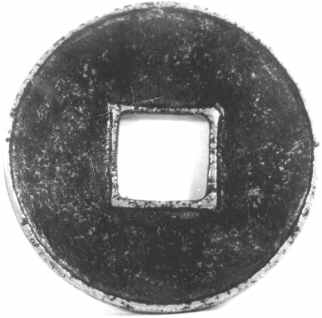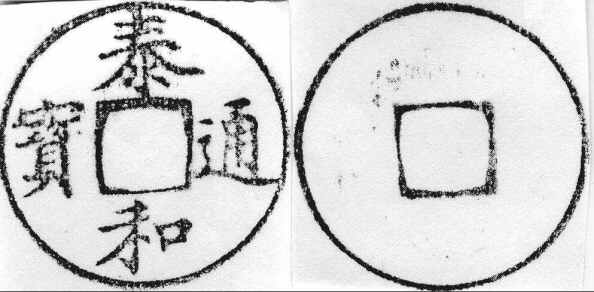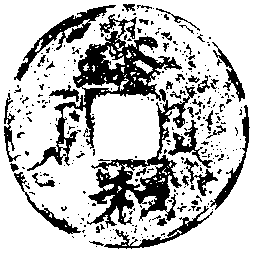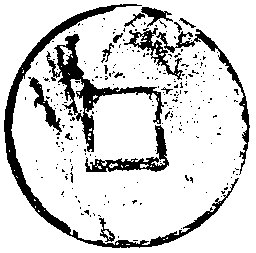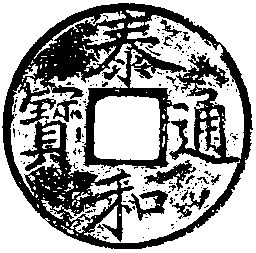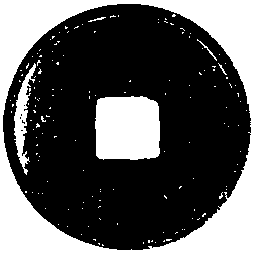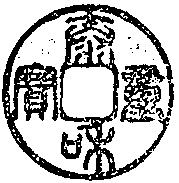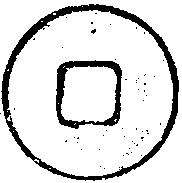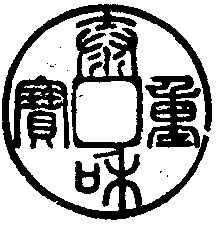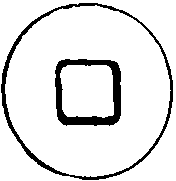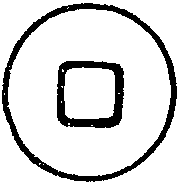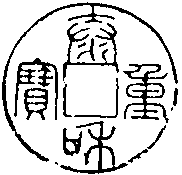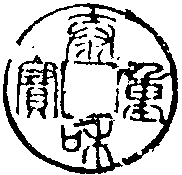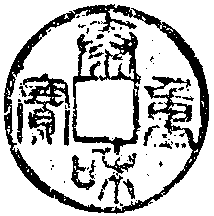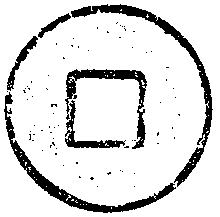A record of the Tai He Tong Bao 10-cash in Normal Script
and Tai He Zhong Bao 3-cash in Seal Script
Gilbert Tan, Wu Xiankang
Singapore, 09-May-98
In recent years, even with the proliferation of ancient Chinese cash in the marketplace; nevertheless, the coins of Liao, Western Hsia, Jin and Yuan Dynasties are still sought after. Amongst these, the most beautiful is the Tai He large cash. The reign title Tai He was used by the Jin monarch Zhang Tsung as his third reign title. The records indicate him as having cast the Tai He Zhong Bao 10-cash in Seal Script during the fourth year and eighth month of Tai He (1204 A.D.). The other varieties of Tai He coins must have also been cast around this time up until the eighth year of Tai He (1208 A.D.) when the new reign title Da An was adopted. Apart from the relatively common Tai He Zhong Bao 10-cash in Seal Script, all other varieties of the reign title Tai He are either very scarce or very rare. The small cash, 2-cash and 3-cash Tai He Tong Bao in Normal Script are very scarce, with the small cash being the rarest among these three. The ultra-large 10-cash Tai He Zhong Bao in Seal Script is also very hard to find. But the rarest are the 10-cash Tai He Tong Bao in Normal Script and the 3-cash Tai He Zhong Bao in Seal Script. What follows is a discussion on the discoveries, pieces known and authentication methods for these two rarest types.
| This variety of coins bearing the reign title of Tai He is very rare. The earliest known two pieces were uncovered during the Republican period in the Peiping District. One had a wide outer rim and thick writing strokes (Rubbing A) while the other had a narrow outer rim and fine writing strokes (Rubbing B), the latter piece being the largest known to exist. Both pieces were initially bought by dealer Fong Song Quan. The Rubbing A piece passed through renowned collector Tao Xing Lu's hands before ending up with Shanghai's Sen Zhi Chuo. The Rubbing B piece was sold to Zhao Guan Zi. Both these pieces now rest in the Chinese Historical Museum which is located next to the Tian An Men Square in Beijing due to the generous donations of these collectors. Before letting these pieces go, Mr.Fong had used these two coins as mother coins to cast multiple fakes which appear very real as such. |  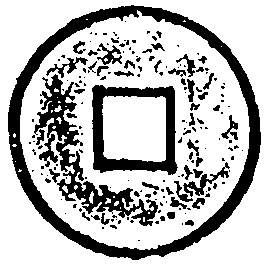 A actual size 44 mm  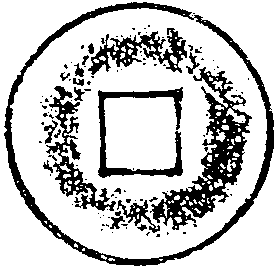 B actual size 46 mm |
|
Only in the 1980s were more pieces discovered, however these were
different varieties being smaller and each with a narrow rim. The
calligraphic style resembled that of the Rubbing B piece but the
thickness of the strokes were between the first two. One piece (Rubbing
C) was acquired by the Shanghai Currency Museum which is located in the
city centre after being certified genuine by renowned ancient Chinese
coin expert, Sun Zhong Hui, who was also the chief curator of the
ancient coins section at that time. In his book entitled Ancient
Coins (April 1990), this piece is described as "a smaller size and fine
strokes variety". One of the authors of this article was also fortunate
to have acquired a piece (Rubbing D) in recent years from a dealer in
Beijing. There is also one piece (Rubbing E) depicted in the book The
Preservation and Authentication of Ancient Coins (November 1985) which
Mr.Sun commented as being "a fake cast from a real piece". In Arthur
Braddan
Coole's Coins in China's
History (1965), there is a photograph of a
coin similar in calligraphic variety to the Rubbing D piece (Illustration F).
From inspecting Rubbing A, one can discern that it was written with the kind of style normally associated with monarchs. It also has the feel of having been penned by someone who was a Nuchen (the original tribe of the Jin Dynasty) but yet was conversant with Song calligraphy. It has an overall northern look and feel. This piece is also the only known of the variety. In the book The Origin and Development of Chinese Money (1939), Harry Glathe presents the Yang Ming Hsiu collection in photographic miniatures, including one (Illustration G) of a fake made from the Rubbing A piece. To date, no other fakes of this variety have been seen by the authors. The Rubbing B variety was written in a completely different style from the Rubbing A one; hence it was named unusual variety by posthumous ancient coin expert and legend Ma Ding Xiang. The beauty of this coin stems not only from the overall calligraphy but also from the intricate end points of each brushed stroke, made undoubtedly by a Song hand. Not being able to inspect these original pieces, we are unable to comment on their appearance in reality; but from the spaciousness and fineness of the writing, we would not be surprised if they were true mother coins. The author has seen the Rubbing C piece during a visit to the Shanghai Currency Museum and speculates that it may be from the North, since it has some patination remaining which looks that way. The calligraphy matches the style of the Rubbing B piece and hence would have been written by the same person. |
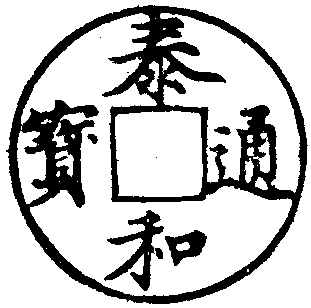 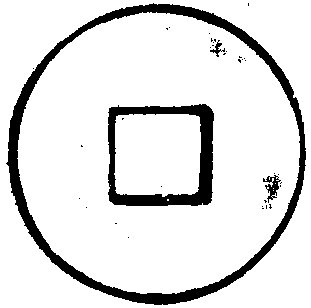 C actual size 42 mm, 18.6 g 
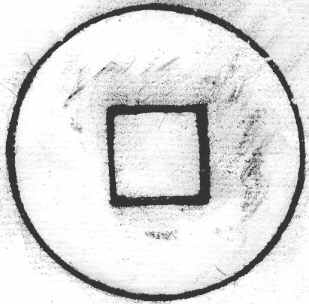 D actual size 42.5 mm 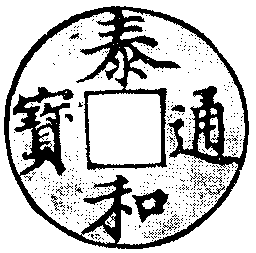 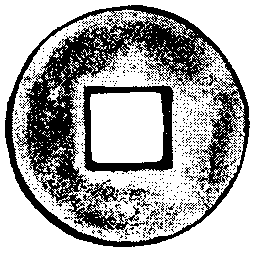 E actual size 41.5 mm 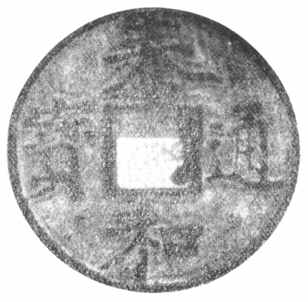 F  G |
The Rubbing D and E pieces as well as the Arthur Coole piece look identical and probably came from the same casting mother coin. When compared with Rubbing C, they are also clearly by the same hand, but from a different casting mother coin as there are some obvious discrepancies in character definition. Whether the Rubbing D and E pieces are another legitimate variant of the "smaller size and fine strokes variety" or the "children" of the Rubbing C variety is worth investigating. The Rubbing D and E pieces are worn pieces with clear aging characteristics. A close inspection of the reverse of the Rubbing D piece reveals aged red patination that is naturally embedded in the field. Also, the style of the inner and outer rims is identical to that of the common 10-cash Seal Script coin. Mr.Sun had commented that the outer rim and the innermost section of the inner rim of the Rubbing E piece did not possess signs of natural aging, but the author's Rubbing D piece clearly has these. Moreover, a comparison of the sizes of the Rubbing C, D and E pieces would show that they are similar both in coin and character size. Hence it is unlikely that the Rubbing C piece could have given rise to the Rubbing D and E pieces. Even if that had been possible, the first (top horizontal) stroke of the He (bottom) character on the Rubbing C piece being obviously shorter than the Rubbing D and E pieces in length and stroke would eliminate any remaining possibility. A further point is that the presence of patination in the Bao (left) character on the Rubbing C piece makes the line patterns appear shallower and thus would not be able to cause a replication of the fineness and depth of this character on the Rubbing D and E pieces. Also, the Tong (right) character on the Rubbing C piece is connected to the inner rim, probably caused by excess copper from the casting. This phenomenon is absent on the Rubbing D and E pieces. Finally, one should not discredit a coin on the basis of the absence of clearcut genuine patination, which is the case for the Rubbing D and E pieces, as the more common 10-cash Seal Script pieces more often than not come in that manner. I wonder if Mr.Sun has some other reason for suspecting the Rubbing E piece.
From the above, we can gather that the Tai He Tong Bao 10-cash coin in Normal Script is undoubtedly a sought after and rare coin and this may be because it was a trial issue which led to the normal issue Tai He Zhong Bao 10-cash coin in Seal Script. To date, the different varieties known are; the wide outer rim and thick writing strokes one (Rubbing A), the large piece with narrow outer rim and fine writing strokes (Rubbing B) [both the above are unique], the smaller piece with the calligraphic style of Rubbing B (Rubbing C - is also the only known and may have been used to mother some fakes before entering the Shanghai Currency Museum), another variety similar to the Rubbing C one (Rubbings D & E) which is still being studied. Rubbing E has not been sighted and so we cannot be sure. But the Illustration D piece is clearly genuine based on the calligraphy and overall look and feel. The embedded red patination is another factor supporting its authenticity. Regardless of whether the 10-cash Normal Script Tai He Tong Bao is a trial issue or an early sample issue, both of which can explain the many varieties, we can say that there are three main varieties and two minor variations within one of them. All the sighted pieces are virtually unique. The legendary Ma Ding Xiang lost an iron piece of the 10-cash Normal Script during the Cultural Revolution. It is a pity that we are unable to view this supposedly different variety now.

